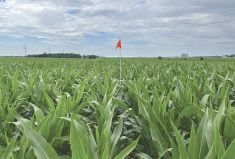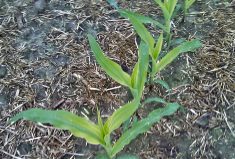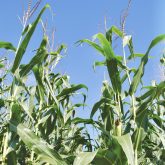Tar spot was first identified in the U.S. in 2015. By 2018, it was beginning to make news in Canada, and every year since then has brought more evidence of its devastating potential.
Alarmingly in late 2021, videos from Midwest U.S.-based agronomists showed infected crops with brown, wilted leaves, and stalks so stressed and weak they looked like styrofoam.
News reports also warned infected crops seemed to dry down with amazing speed. Fields that normally matured through September and October now dried in just a single week, with yield losses ranging from 60 to 100 bu./ac.
Read Also

Producers aren’t panicking over tariffs and trade threats
The Manitoba Canola Growers Association (MCGA) surveyed its members this spring to get a sense of how trade uncertainty was…
That said, there is still much to learn about tar spot and its potential impact on corn crops in Eastern Canada. Researchers and agronomists are studying all aspects affecting corn production — from hybrid susceptibility to tillage practices to the pathogen’s ability to overwinter. Everything is on the table for examination and discussion.
In 2020, tar spot was found in low levels and low severity in Essex, Kent, Lambton, Elgin and Middlesex counties. A few fields were estimated to have infection rates up to 10 to 15 per cent but only in small pockets. Most of the discoveries came towards the end of September, but according to Rob Miller, technical development manager with BASF Canada, 2021 saw “perfect storm” conditions for tar spot, allowing the disease to spread to 14 more counties, east into Niagara and north into Grey, Bruce, Dufferin and Simcoe.
Still, the call is for a broader understanding of diseases in corn. Yes, tar spot must be monitored closely heading into 2022 as it has the potential to severely affect yields. BASF’s corn trials reported losses of more than 60 bu./ac. in some plots. But it’s not the only disease affecting corn yields and marketability. There’s also more to it than how it infects the leaves.
“This past year, we had a lot of leaf disease, so northern corn leaf blight, tar spot and stalk rots,” says Miller. “Stalk rot is actually infection in the roots and there are hybrid differences, there are environmental conditions and tillage practices. It’s all a complete package so it’s not just one solution.”
Miller emphasizes that tar spot is still in its early stage and there’s a considerable amount of information that needs to be gathered, analyzed and shared.
Surprising spread
When asked for his assessment of tar spot’s potential impact on Ontario corn production, the Ontario agriculture ministry disease specialist Albert Tenuta agrees with Miller, noting he first detected the disease last summer in west Elgin County during the first week of July. After that, frequent high humidity helped it spread north and east.
“The buildup of tar spot, in terms of geography and inoculum, was setting it up so it would be inevitable,” says Tenuta, who points to high infection rates in nearby Michigan. “This disease, like many other airborne diseases, moves with storms and rain events, and with that much inoculum so close to Ontario, I wasn’t surprised that we would have seen it.”
What did surprise him was how quickly it developed. Like many other diseases, tar spot has multiple generations during a season, and each one can produce inoculum that affects more plants, creating exponential growth.
There was another disturbing 2021 trend as well. The most common comment Tenuta heard from growers and retailers is that every field has some, which was the biggest difference from 2020.
“That sets us up for 2022. It is endemic, it is established,” Tenuta says. “The weather will drive a lot of this disease, but it’s one we need to respect, not fear. The take-home message from 2021 is that we do have tools available to us even though we have to predict what our integrated tar spot management program is going to look like. We need to tweak them to maximize efficiency in terms of control while minimizing yield impacts.”

Increased lodging
As for images and videos of brittle, breakable corn stalks from the U.S., Miller and Tenuta note that what happens with tar spot occurs with any foliar leaf disease, including northern corn leaf blight. If a corn plant is under stress from a leaf disease, this will inhibit the photosynthesis, forcing the crop to rob energy from other parts of the plant to fill grain. The result is that styrofoam-like spongy appearance in the stalk, leading to more lodging.
“Since it moves so rapidly and progresses so quickly, tar spot causes that corn plant to cannibalize the stalk and that’s where we start to see differences in standability,” says Miller. “This year, we were having a lot of stalk rots and lodging issues, so it’s not just from tar spot. We were seeing a lot of anthracnose and fusarium stalk rot and that goes back to planting conditions last spring and the disease’s development through summer.”
Where tar spot becomes more of a concern is in the overwintering of its spores. It appears to have more overwintering capability than northern corn leaf blight, and especially compared to leaf rust which needs spores to be blown in every year as it only infects living green tissue.
Since tar spot can overwinter on dead tissue, it has the potential to become more established and move throughout the region.
“Overwintering will be big in Ontario, especially if we do see it come in earlier in the season than in 2020,” notes Miller. “If you go back in with that host crop — like a corn-on-corn scenario — and start to see it on the bottom, it means it splashed up from the residue. If you see it on the top part of the canopy that means it blew in from neighbouring counties or fields, or on weather patterns from the U.S.”
That’s what makes identification all the more important. There are a lot of look-alike diseases. Saprophytic fungi that feed on the leaf tissue, symptoms of leaf rust or eyespot and insect frass (droppings) can all be mistaken for the characteristics of tar spot.
Some better news
Despite the sizeable potential for yield losses, Tenuta notes there are some positive signs from fungicide trials in 2020. Although there’s nothing known to be resistant to tar spot, there are varying degrees of partial resistance or tolerance. Hybrid selection is going to be a big part of that integrated tar spot management process and Tenuta is working with Dr. Dave Hooker (University of Guelph’s Ridgetown Campus), the Ontario Corn Committee as well as private and public breeding sectors on that subject. He had 64 hybrids in his research trial location in West Elgin County and the majority were susceptible.
“But the good news is we have a lot of products that are effective, and some more than others,” says Tenuta. “Some were getting back 30 to 40 bu./ac., which is pretty significant when you think of a fungicide trial. It’s similar to our northern corn leaf blight trials where we lost 60 bu./ac., and some of those were in the 40s and 50s, as well.”
Tenuta also worked with U.S. colleagues on fungicide timing with naturally infected fields, letting the disease progress during the season. This Tar Spot Working Group targeted the same VT/R1 application window for gibberella ear rot, and aside from that fungicide benefit, Tenuta wound up with a 16-bushel advantage. The susceptible hybrid yielded 201 bu./ac. and a tolerant hybrid yielded 217 bu./ac, without fungicide.
Tenuta also stresses the importance of taking an integrated management approach which includes hybrids, scouting, fungicides and forecasting tools such as the Tarspotter app in the battle with the disease.
Will longer rotations help? Tenuta says it’s uncertain. Tar spot’s spores can survive at least one year and maybe up to two years. Still, because tar spot spores can be air-borne, corn-on-corn may face a higher risk but only 10 to 20 per cent higher than longer rotations.
















